This is the second of four articles, each of which looks at who was living in Ware High Street in 1911. This one covers the second half of the odd-numbered buildings on the south side, from No. 55 to No. 111.
No. 55 was a private house, but was uninhabited at the time the 1911 census was taken. It is now a Grade II listed building.
According to Bennett’s Business Directory (1911-12 edition) No. 57 was the premises of a builder and contractor called F. Hitch, whose telephone number is given as 195, but both the 1910 and 1912 editions of Kelly’s Directory of Hertfordshire refer to Frederick Hitch & Co., builders, in Church Street, Ware. This would seem to be more accurate as the 1911 census enumerator lists a lawyer’s office and two maltings (associated with the Mr Harrington mentioned in Part 1) at No. 57 in the High Street.
A branch of the London County & Westminster Bank Limited was located at No. 59, a large 11-room building appropriately called Bank House. The manager was James Castle, 50, originally from Deal in Kent, who was also treasurer to the Urban District Council. He lived on the premises with his wife Louie, 41, from Catford in Kent, and their two young sons, Edward, 5, and Alexander James, 4, both of whom had been born in Forest Gate in Essex. Two employees lived with the family ̶ Emily Hannah Wilkinson, 21, from Hoddesdon, Hertfordshire, was a domestic servant, and Annie Elizabeth Spriggs, 17, from Hornsey in Essex, was a ‘general nurse domestic’.
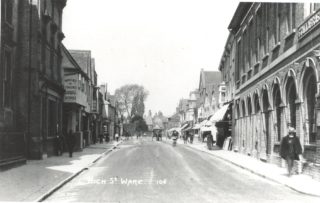
Looking west, Woollatt & Coggin Drug Store can be seen on the left (credit: Hertfordshire Archives & Local Studies)
There was a chemist and druggist at No. 61 (now a Grade II listed building), trading under the name Woollatt & Coggin. The 6-room building was the home of Archibald Henry George Coggin, 45, from Weston, Hertfordshire. He lived there with his wife Mary Ellen, 38, who originally came from Northampton, and their two young children − Geoffrey Archibald, 5, and Joyce Aubey, 1, both of whom had been born in Ware. The name Woollatt may well have related to Samuel Parter Woollatt, who was listed in the 1891 and 1901 censuses as a chemist from Stevenage, Hertfordshire, and who was the uncle of Archibald Coggin.
No. 63 was the site of a malting business, Henry Ward & Sons, and the large 10-room building was also the home of William Stacey Ward, 34, who was Henry Ward’s son and who worked there as a malster. The trade directories of the time list a W. S. Ward as secretary of the Young Men’s Friendly Society − likely to be the same person. He was married to Edith, 35, from Bromley in Kent. They had two servants, Alice Mary Bull, 20, from Little Hormead near Buntingford, Hertfordshire, who was their cook, and Emma Jane Matthews, 30, from Little Hadham, Hertfordshire, who was a housemaid. The building was formerly the Royal Oake Inn and is probably the oldest building in the High Street.
Nos. 65 to 73 included a block of shops, a malthouse and some stables, all of which were associated with local man Robert William Harradence, 55, who was a draper and outfitter. Nos. 65 and 67 are now Grade II* listed buildings, and Nos. 69, 71 and 73 are now Grade II listed.
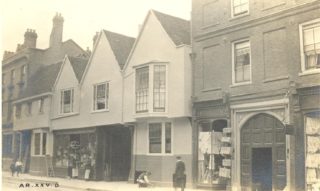
This shows Robert Harradence’s shop at No. 65 on the right (credit: Hertfordshire Archives & Local Studies)
Mr Harradence lived on the premises, which had about 30 rooms in total, with his family and their servants, as well as several of his employees. His wife was J. A. Beatrice, 55, from Hertford, and they had four children, three of whom were still living with them − Herbert J., 30, who worked with his father in the draper’s shop, R. Geoffrey, 28, who was a bank clerk, and Hilda, 27. Other members of the family living there included Robert’s widowed aunt, Wilhelmina Gage, 79, originally from Stepney in London, and his sister-in-law, Mary Williams, 69, from Hatfield, Hertfordshire. They had four servants in their employ − Fanny Hunter, 42, from East Winch in Norfolk, who was their housekeeper, Alice Mobbs, 21, from Pentney in Norfolk, who was the cook, and two general domestic servants, Maria Saville, 32, from Eastwick, Hertfordshire, and Emily Mobbs, 19, who was Alice’s sister, also from Pentney in Norfolk.
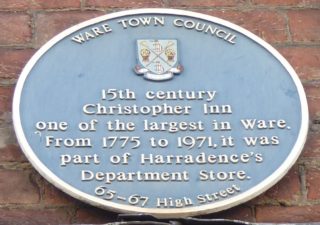
This plaque commemorates the 15th-century Christopher Inn and can be seen on the building that was occupied by Harradence’s department store (credit: Caroline Churton)
Living alongside this large family household were six of Robert’s employees. These included five draper’s assistants − Cyril Peachey, 26, from Newmarket in Cambridgeshire, Norman Head, 21, from Bromley in Kent, George R. Jeffrey, 17, from Stepney in London, Ann McLean, 35, from Glasgow in Lanarkshire, and Sarah Budgett, 45, from Radstock in Somerset. The other employee was Lilly Lyson, 27, from Kibworth in Leicestershire, who worked as a clerk.
There was a shop next door at No. 75 (now Grade II listed), a 9-room building, run by grocer and provision dealer Henry Hicks, 63. His sister, Emily, 61, who was single, lived there too, and according to the census she was employed as a ‘fancy draper’. Both were originally from Feering in Essex. The enumerator also lists a slaughterhouse at the rear of No. 75.
There was a tailor’s shop at No. 77 (now a Grade II listed building), the business having been established in 1780, according to Bennett’s Business Directory (1911-12 edition). Arthur James Culver, 56, a local man from Ware, was described as a ‘ladies’ and gentlemen’s tailor’ (and also ‘deputy registrar of births & deaths for Ware sub-district’) and he lived on the premises with his large family. He was married to Ada Louisa, 51, from Hertford, and they had 11 surviving children (two others had died), six of whom still lived at home. Ada Dochra, 25, was a school teacher, Hilda May, 20, was a linen draper’s shop assistant, and Hubert Adams, 18, was a tailor’s assistant. The three younger children, Freda Olive, 13, Iris Audrey, 10, and Millicent Ethel, 8, would have been still at school.
Also at this address were two malthouses occupied by Henry Ward & Sons, whose main business was based at No. 63.
John Wren Brewster, 42, was a fishmonger and poulterer, originally from Hoddesdon, Hertfordshire, and he had a shop at No. 79 (now a Grade II listed building). His wife was Ada Florina Jane, 39, from Stoke Newington in London, and they had two children, both of whom had been born in Ware. Lawrence John, 16, was employed as an apprentice to a coppersmith, and Florence Eliza, 15, worked as an apprentice to a draper. A general domestic servant, Bertha Andrews, 21, from Ware, lived in the 9-room house with the family.
No. 81 was a private residence (now a Grade II listed building), the home of Mabel Ellen Lawrence, 34, and her sister Lizzie Lawrence, 32. They had taken in two boarders, Archibald Houston Andrew, 27, from Haddington in East Lothian, who was a veterinary surgeon, and Henry Sheffield Clapham, 35, from Kingston upon Hull in Yorkshire, who was a solicitor. There was one domestic servant in the household, Eliza Harwood, 19, from Stanstead Abbotts, Hertfordshire. The premises, which had 10 rooms, would appear to have included a veterinary practice, as the 1910 and 1912 editions of Kelly’s Directory of Hertfordshire both list Golding & Andrew, veterinary surgeons, at this address. They include references to ‘Archibald H. Andrew, MRCVS, veterinary surgeon. Nat. Tel. No. 197’ and ‘Walter W. Golding, MRCVS, veterinary surgeon & inspector under the Contagious Diseases (Animals) Act for Ware division’. The enumerator’s list also refers to stables under the names of Lawrence and Golding at this location. Walter Wyndham Golding lived at 25 Old Cross in Hertford.
At No. 83 (now a Grade II listed building) could be found a ‘beer house’, otherwise known as The Brewery Tap, a name still familiar to Ware residents today. Living on site was the manager, Albert Pike, 28, originally from Egham in Surrey, along with his parents and three brothers. His father, Charles Henry, 61, who was an invalid, came from Bainsby (?) in Wiltshire, and his mother, Elizabeth, 59, from Crookham in Hampshire. Of the ten children they had had, only five had survived; the three still living with them were Earnest Harry, 28, born in Egham in Surrey, who was employed as a barman, Frank William, 23, also born in Egham, who was a gardener, and Arthur, 16, born in Ware, who worked as a house boy. There was also a maltings at this address, occupied by the well-known Ware malster, Henry Page, whose company offices were next door.
These offices, at No. 85, consisted of just two rooms and the caretaker, Esther Jane Boulton, a 49-year-old widow from Ware, lived on the premises.
In 1911 No. 87 was a large private house, with 12 rooms. On the night of the census only the housekeeper, Rosa Susanna Jackson, a 71-year-old widow who came from Kingsbridge in Devon, was in residence, but according to Kelly’s Directory of Hertfordshire (1910 and 1912 editions) this was the home of a Mrs Croft (the mother of local malster Henry Page, whose full name was Henry Page Croft). She had some stables here as well, and Henry Page & Co. also had another malthouse at the rear of the premises. The building, now Ware’s library and Grade II* listed, is of historic interest as it was built in 1765 on the site of the Crown Inn, which was reputedly the original home of the Great Bed of Ware.
No. 89 was the lodge at Ware Priory, which had two rooms and was occupied by Elisa Hornett, 65, from Ware, in her role as lodge keeper. The building is now Grade II listed.
There was a public house, the Eagle, at No. 91. The ‘beer house keeper’, as the census described him, was George Henry Coningham, 52, from West Ham in Essex, and he lived there with his wife Nelly Simpson, 50, from west London, who was a shopkeeper and dealer, and their 13-year-old grandson, William Vallins, from Peckham in London.
No. 93 was a private residence, the home of local man James George Prior, 55, who worked as a general labourer. He was married to Elizabeth, 53, originally from Braughing, Hertfordshire, and they had had six children, although one had died. Three of the surviving children, all of whom had been born in Ware, lived with them − Walter, 19, who was a labourer like his father, John, 17, garden hand, and George, 15, who was still at school but was also a paper boy.
No. 95 was the home of Mary Braund, a 75-year-old widow, from Ashwell, Hertfordshire. She was a lady of private means, as were her two daughters, Beatrice, 41, born in Watford, Hertfordshire, and Rosa, 37, born in Ware. Their brother, George, 36, was employed as an engineer’s clerk. The large house had nine rooms.
The next building listed (but unnumbered) by the census enumerator is The Priory. This Grade I listed building was founded in 1338 and over the centuries it has been a friary, a private house and a convalescent hospital during the First World War. In 1911, according to the enumerator, it was a private residence, occupied by seven people (two males and five females) with the name of the main occupier given as a Mr Walters (?). No further information is provided. Currently The Priory is the location of offices for Ware Town Council and a venue for events.
There appear to be no further listings in either the census or the local trade directories for buildings on the south side of the High Street until No. 111. Here was a grocer, Alfred Lee, 61, originally from Cheltenham in Gloucestershire, who lived on the premises, which had 5 rooms, with his wife Esther Garland, 62, from Bristol, who assisted him in the business. They had two sons, William Henry, 33, who had also been born in Bristol and who worked as a house agent and rate collector, and Alfred, 28, born in Ware, who was employed as a railway goods clerk, A third child had died.
Click on each picture to enlarge.
See also separate articles on the High Street, Ware, 1911: Part 1 (Nos. 1-53), Part 3 (Nos. 2-56) and Part 4 (Nos. 58-120).
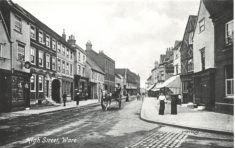
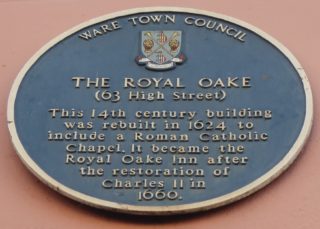
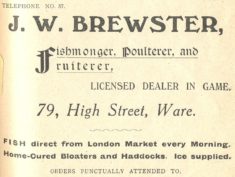
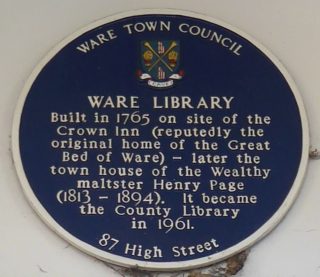


Add your comment about this page